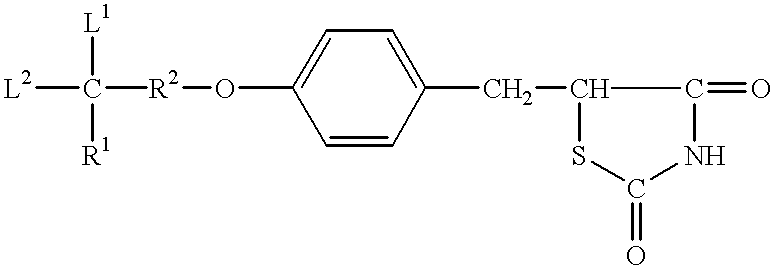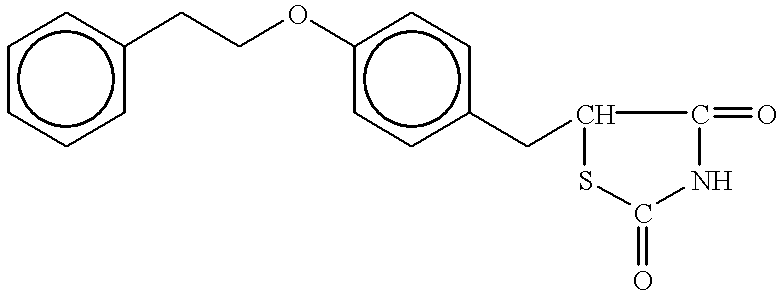Thiazolidinedione, oxazolidinedione and oxadiazolidinedione derivatives
a technology of oxadiazolidinedione and thiazolidinedione, which is applied in the field of insulin resistance, can solve the problems of unsatisfactory effects and considerable increase in liver lipids
- Summary
- Abstract
- Description
- Claims
- Application Information
AI Technical Summary
Problems solved by technology
Method used
Image
Examples
working examples
Example 1
4-Cyanophenethyl methanesulfonate
3.7 g (25 mmole) p-cyanophenethylalcohol was dissolved in 15 ml dichloromethane, 5.2 ml (87.5 mmole) triethylamine was added and the mixture was cooled on an ice bath. 2.52 ml (32.5 mmole) methanesulfonyl chloride in 5 ml dichloromethane was slowly added at 0-7.degree. C. The reaction was allowed to reach room temperature and then stirred at room temperature. The reaction mixture was washed with cooled 2 N hydrochloric acid, water, dried (sodium sulfate), filtered and the solvent was evaporated in vacuo to give 5.3 g (yield 95%) of 4-cyanophenethyl methanesulfonate.
4-[2-(4-Formylphenoxy)ethyl]benzonitrile
8.55 g (38 mmole) 4-cyanophenethyl methanesulfonate, 4.64 g (38 mmole) p-hydroxybenzaldehyde and 18.7 g (57 mmole) cesium carbonate in 150 ml acetonitrile was refluxed over night. The salt was filtered off and the solvent evaporated in vacuo. The residue was treated with 2 M sodium hydroxide and dichloromethane. The organic phase was dried a...
example 2
5-([4-Benzyloxyphenyl]methyl)oxazolidine-2,4-dione
5.5 g (19.2 mmole) 2-hydroxy methyl 3-(4-benzyloxyphenyl)propionate, 1.98 g urea, 1.38 g sodium methoxide, 4.9 ml methanol and 49 ml ethanol was stirred for 2 hours at room temperature, then refluxed over night. The reaction mixture was poured on to 305 ml 2 N hydrochloric acid. The product was extracted with ethyl acetate, washed with aqueous sodium bicarbonate, dried and the solvent was evaporated in vacuo. The crude product was purified by chromatography on silica gel using dichloromethane:methanol (95:5) as eluent to give 2.75 g (yield 48%) of 5-([4-benzyloxyphenyl]methyl)oxazolidine-2,4-dione.
5-([4-Hydroxyphenyl]methyl)oxazolidine-2,4-dione
2.75 g (9.25 mmole) 5-([4-benzyloxyphenyl]methyl)oxazolidine-2,4-dione was hydrogenated at 50 psi over night in 1,4-dioxan using Pd / C as catalyst to give 1.8 g (yield 94%) of 5-([4-hydroxyphenyl]methyl)oxazolidine-2,4-dione.
3-Triphenylmethyl-5-([4-hydroxyphenyl]methyl)oxazolidine-2,4-dione
0.33...
example 3
2-[2,4-Di(benzyloxy)phenyl]-1-ethanol
10 ml (20 mmole) 2 M borane dimethyl sulfide complex in diethyl ether was slowly added to 6.3 g (18.1 mmole) 2,4-dibenzyloxyphenyl acetic acid dissolved in 50 ml dry tetrahydrofuran cooled on an ice bath under nitrogen and then stirred for 7 days at room temperature. The reaction was quenched with water and extracted with ethyl acetate, dried with magnesium sulfate and evaporated. The crude product was purified by chromatography on silica gel using dichloromethane / methanol as eluent to give 2.63 g of the desired product and a mixture of 2,4-dibenzyloxyphenyl acetic acid and the desired product. The mixture was dissolved in 100 ml ethyl acetate, 0.152 g (4 mmole) lithium aluminum hydride was added in portions and the mixture was stirred at room temperature for 6 hours. After 4 hours some more lithium aluminum hydride was added. The reaction was quenched with 1% hydrochloric acid and the solution was filtered. The filtrate was dried with magnesium ...
PUM
| Property | Measurement | Unit |
|---|---|---|
| Electrical resistance | aaaaa | aaaaa |
| Bond | aaaaa | aaaaa |
Abstract
Description
Claims
Application Information
 Login to View More
Login to View More - R&D
- Intellectual Property
- Life Sciences
- Materials
- Tech Scout
- Unparalleled Data Quality
- Higher Quality Content
- 60% Fewer Hallucinations
Browse by: Latest US Patents, China's latest patents, Technical Efficacy Thesaurus, Application Domain, Technology Topic, Popular Technical Reports.
© 2025 PatSnap. All rights reserved.Legal|Privacy policy|Modern Slavery Act Transparency Statement|Sitemap|About US| Contact US: help@patsnap.com



